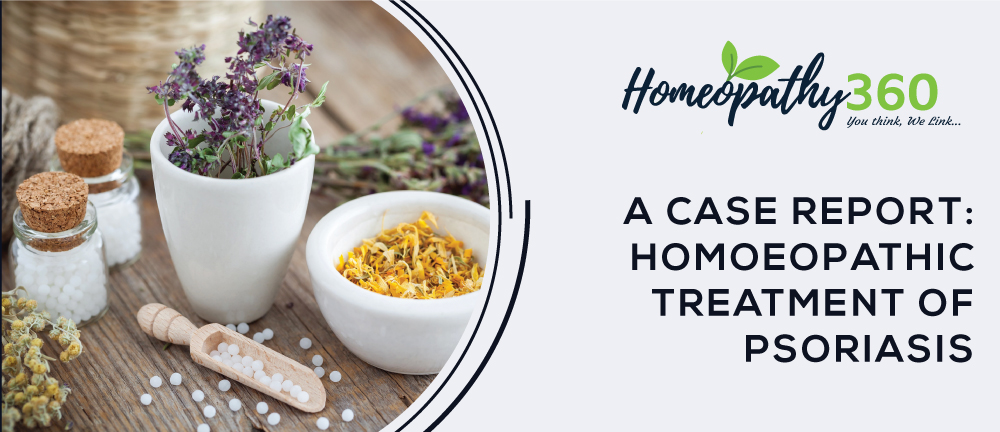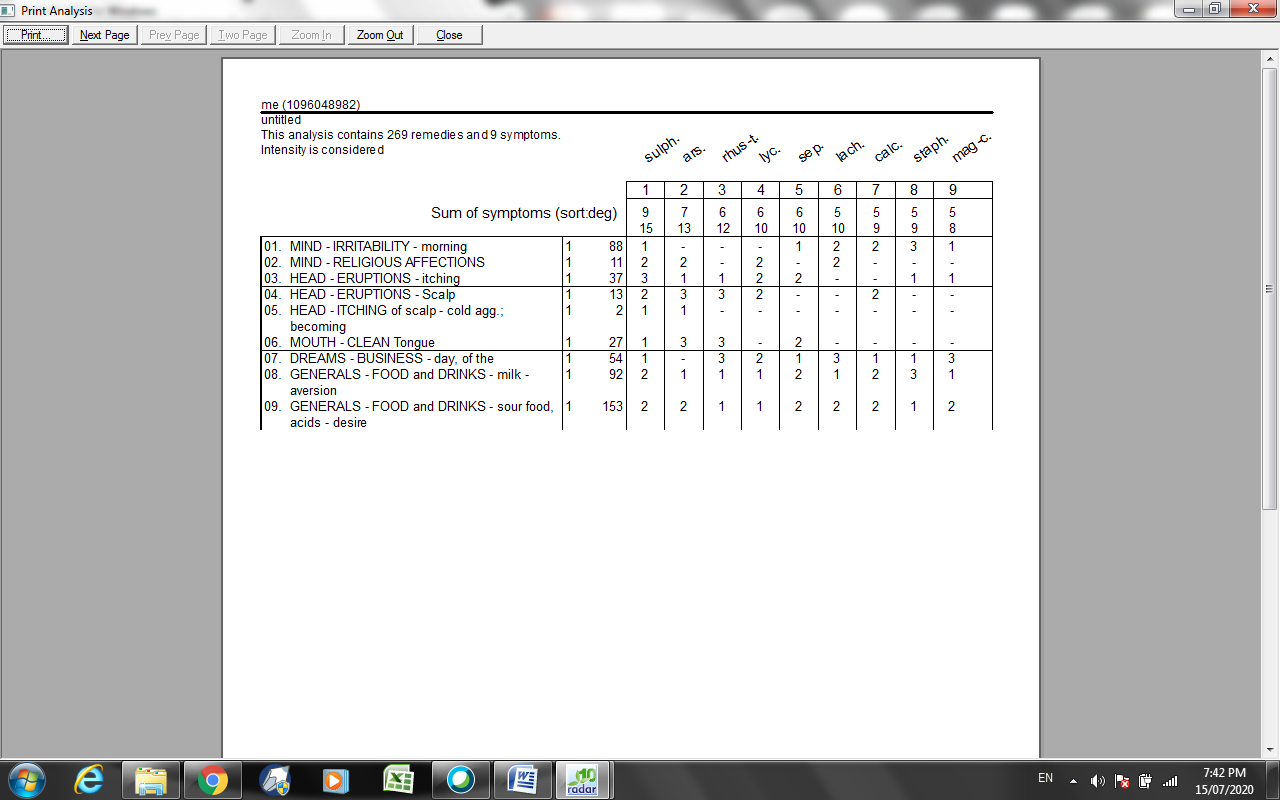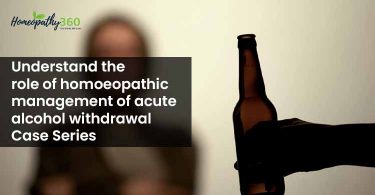
ABSTRACT- Psoriasis is one of the most common skin diseases nowadays, as in the most of the cases, the exact cause is unknown. Psoriasis is a auto-immune disorder which is very difficult to cure as after treatment its recurrence rate is very high as it recur after 5-6 months of treatment but by homoeopathic treatment, one cannot only cure the disease but can control the recurrence rate. Homoeopathy, however, provides a better response in such condition, one such case report is presented below. Patient attended outdoor patient department (OPD) for complaints of severe itching of scalp, dandruff, scaling and shinning of scalp. She was suffering from scalp psoriasis for 2 years. After unsatisfactory outcome from modern medicine and ayurvedic, patient turned to homoeopathic treatment. After case taking, repertorisation, and miasmatic point of view, Sulphur was prescribed, and gradually, the potency was increased as per response of medicine upon patient. Within 1.5 year of homoeopathic treatment, the patient started improving, and continued to be free from his complaint at the time of last follow-up visit in OPD.
KEYWORDS– Psoriasis, auto-immune disorder, recurring, Sulphur, homoeopathy, miasmatic treatment.
ABBREVIATIONS- quality of life (QoL), outdoor patient department (OPD), non-communicable diseases (NCDs).
INTRODUCTION– Psoriasis is a chronic, non-communicable, painful, disfiguring and disabling disease for which there is no cure and with great negative impact on patients’ quality of life (QoL). It can occur at any age, and is most common in the age group 50–69. The reported prevalence of psoriasis in countries ranges between 0.09% and 11.4%, making psoriasis a serious global problem. The etiology of psoriasis remains unclear, although there is evidence for genetic predisposition. The role of the immune system in psoriasis causation is also a major topic of research. Although there is a suggestion that psoriasis could be an autoimmune disease, no auto-antigen that could be responsible has been defined yet. Psoriasis can also be provoked by external and internal triggers, including mild trauma, sunburn, infections, systemic drugs and stress(1). Psoriasis involves the skin and nails, and is associated with a number of co-morbidities. Skin lesions are localised or generalised, mostly symmetrical, sharply demarcated, red papules and plaques, and usually covered with white or silver scales. Lesions cause itching, stinging and pain(2). Between 1.3% and 34.7% of individuals with psoriasis develop chronic, inflammatory arthritis (psoriatic arthritis) that leads to joint deformations and disability. Between 42% and 69% of all patients suffering from psoriasis develops nail changes. Individuals with psoriasis are reported to be at increased risk of developing other serious clinical conditions such as cardiovascular and other non-communicable diseases (NCDs). Psoriasis causes great physical, emotional and social burden. There is also a significant cost to mental well-being, such as higher rates of depression, leading to negative impact for individuals and society. The treatment of psoriasis is still based on controlling the symptoms. Topical and systemic therapies as well as phototherapy are available. In practice, a combination of these methods is often used. The need for treatment is usually lifelong and is aimed at remission with so many side-effects on body by these treatment. So far, there is no therapy that would give hope for a complete cure of psoriasis.
CLINICAL PRESENTATION–
The onset of scalp psoriasis is often with seborrhoeic dermatitis. Dandruff tends to itch more and it has a greasy appearing yellow scale. Scalp psoriasis may itch and become easily irritated during a flake, however, it may also affect your hairline or creep down onto your forehead, nape of neck or ears.
Psoriasis is common on scalp at least 50% of the people have plaque psoriasis.
– red skin covered with flakes and shiny scales.
– skin flakes (dandruff) that may attach to the hair shaft.
– patchy shiny scales or thick crust on the scalp that may bleed when removed.
– patches that may extend beyond hairline or appear on other parts of the body.
Itching and irritation will be there.
Inflammatory, red, sharp, demarcated, raised, dry, differently sized plaques, usually covered by silvery or white scales. Involves the scalp and the area behind the ear, the exterior surface of the forearm, skin on bends(3).
INVESTIGATION– Diagnosis of psoriasis is typically made by a physical examination, medical history and relevant family history. Some laboratory test including microscopic examination of skin biopsy and x-ray may be useful.
As in modern medicine they use tropical treatment and tropical corticosteroid but these drugs are having side-effects which affect the body in several ways. The harms liver, kidney, causes acne, burning, dilated blood vessel, irritation and loss of skin colour. Loss of effectiveness- after some time the patient become used to this type of treatment and these will not work on patient anymore(4).
CASE REPORT–
A 20 years old female patient attended out-patient department in December 2018 with the following complaints:
Scaling with severe itching of scalp since 2 years especially in cold weather, or on becoming cold. Severe itchy eruptions and falling of dandruff and hair since 2 years with burning on itching with watery discharge after scratching especially in cold weather.
History of present complaints-
She was under treatment on both allopathic and ayurvedic system of medicine but it gives temporary relief after 2 years of suffering she visited our OPD in December 2018.
Personal history-
Addiction- nil
occupation- student
Past history- patient suffered from chicken pox 3 years ago.
Family history- Both mother and father suffered from Diabetes. And brother suffers from dandruff.
Generals –
Her appetite was good but cannot remain empty stomach for prolonged period. She had desire for sour food, acid, bitter, and warm food and thirst is moderate amount with scanty perspiration. Bowel movement was regular and has to go in early in the morning. Thermal reaction of patient was hot (preferred winter and cannot tolerate heat) and always irritable in morning with religious affection. A general feeling of weakness accompanies the patient most of the time.
Local and systemic examination-
Tongue was clean and moist.
Aanemia- mild.
Diagnosis – By accessing the sign and symptom clinically it probably a case of plaque psoriasis (scalp).
Analysis of symptoms-
After analysing the symptoms of the case, the following characteristic mental, physical and particular symptoms were considered for framing totality:
Morning irritability with religious affection
Lassitude in general
Desire for sour food and acid with early morning diarrhoea
Miasmatic evaluation using “The Chronic Diseases” by Dr Samuel Hahnemann showed the predominance of psoric miasm.(5)
Considering the above mentioned symptoms, Kent’s Repertory was preferred and done by RADAR software systemic repertorisation(6). Repertorisation sheet is given below.

Sulphur 200, 1 dose was prescribed along with Rubrum 200 on first visit on 18 december 2018 considering the reportorial totality and miasmatic background. The patient was improved symptomatically as compared to before on 12/01/2019.
Discussion
After repertorisation, many medicines, namely, Sulphur, Arsenicum album, Lycopodium clavatum, Rhus toxicodendron, Sepia officinalis, Hepar sulphuricum, Lachesis mutus, etc. came up but after consulting materia medica,(7)Sulphur was prescribed which remain unchanged in the subsequent follow up and patient was responding well to medicine. Sulphur also covered the miasmatic background of the case.
Time including follow up-up of the case:
| Follow-up date | Indication for prescription | Medicine with dose |
| 18.02.2019 | Scaling was better, itching was better, pain in abdomen since 1 week<night, after eating; > in empty stomach, thirst- moderate, tongue- clean | Rubrum/ 2 weeks |
| On 04.03.2019 | Scaling better, itching better, pain in abdomen better, thirst- moderate. Tongue- clean | Rubrum/ 2 weeks |
| On 15.04.2019 | Itching was better, scaling was better, loss of appetite was better, irritable in morning was better Thirst- moderate Tongue- clean | Rubrum/ 2 weeks |
| On 15.05.2019 | Itching aggravated than before, scaling aggravated than before, loss of appetite was better, irritable in morning was better Thirst- moderate Tongue- clean | Rubrum/ 2 weeks |
| On 27.05.2019 | Itching aggravated, scaling aggravated, loss of appetite was better, irritable in morning was better, thirst- moderate. Tongue- clean | Sulphur 1M/1 dose Rubrum/ 2 weeks |
| On 24.06.2019 | Itching was better, scaling was better Loss of appetite was better, thirst moderate. Tongue- clean | Rubrum/ 2 weeks |
| On 31.07.2019 | Itching was better, scaling was better, loss of appetite was better, cough and cold Thirst- moderate Tongue- clean | Rubrum/ 2 weeks |
| 5.09.2019 | Itching was better, scaling was better, loss of appetite was better, cough and cold was better, thirst- moderate, tongue- clean, stool- satisfactory, urine- clear | Rubrum/ 2 weeks |
| 05.03.2020 | There was no itching, no scaling, no lesion found, thirst- moderate, tongue – clean, urine clear, stool- satisfactory, appetite was good. | Rubrum/ 2 weeks |
| 08.04.2020 | Better | Rubrum/ 2 weeks |
Conclusion
Homoeopathy treats the person as a whole, it eliminates the exciting and fundamentals cause by annihilating the disease manifestation (sign and symptoms). As psoriasis is an auto-immune disease It is very difficult to treat as its recurrence rate is very high, homoeopathy by taking the totality of symptom annihilate the sign and symptoms with no recurrence rate.
References –
- Global report on psoriasis by WORLD HEALTH ORGANISATIOn.
- Guerra I, Gisbert JP (January 2013). “Onset of psoriasis in patients with inflammatory bowel disease treated with anti-TNF agents”. Expert Rev Gastroenterol Hepatol. 7 (1): 41–8. doi:10.1586/egh.12.64. PMID 23265148.
- Fry, L; Baker, BS (2007). “Triggering psoriasis: the role of infections and medications”. Clinics in Dermatology. 25 (6): 606–15. doi:10.1016/j.clindermatol.2007.08.015. PMID 18021899.
- http://www.wellinghomoeopathy.com/treatment-for-psoriasis.
- Hahnemann S. The chronic disease their peculiar nature and their homoeopathic cure. Low price edition. New delhi: B jain publishers pvt. Ltd;2002. P46.61-2
- Kent JT. Repertoryof the homoepathic material medica. Enriched indiaan edition reprinted from 6th American edition. New delhi: b jain publishers pvt ltd.2000
- Boericke W. Pocket Manual of Homoeopathic Materia Medica Comprising the Characteristic and Guiding symptoms of all Remedies [Clinical and Pathogenetic]. Ninth Edn. Calcutta: Modern Homoeopathic Publication; 1997.
- Longo Dan L., Kasper Dennis L., Jameson J., Larry, FauciAnthonys, Hause Stephen L.Loscalzo Joseph: Harrison’s Principle of Internal Medicine; 18th Edition; vol-2 Megrawhill Medical.
About Author:
Dr Hozaifa Ayubi
PG Scholar, Department Of Practice Of Medicine
R.B.T.S Government Homoeopathic Medical College And Hospital,
Muzaffarpur, Bihar




